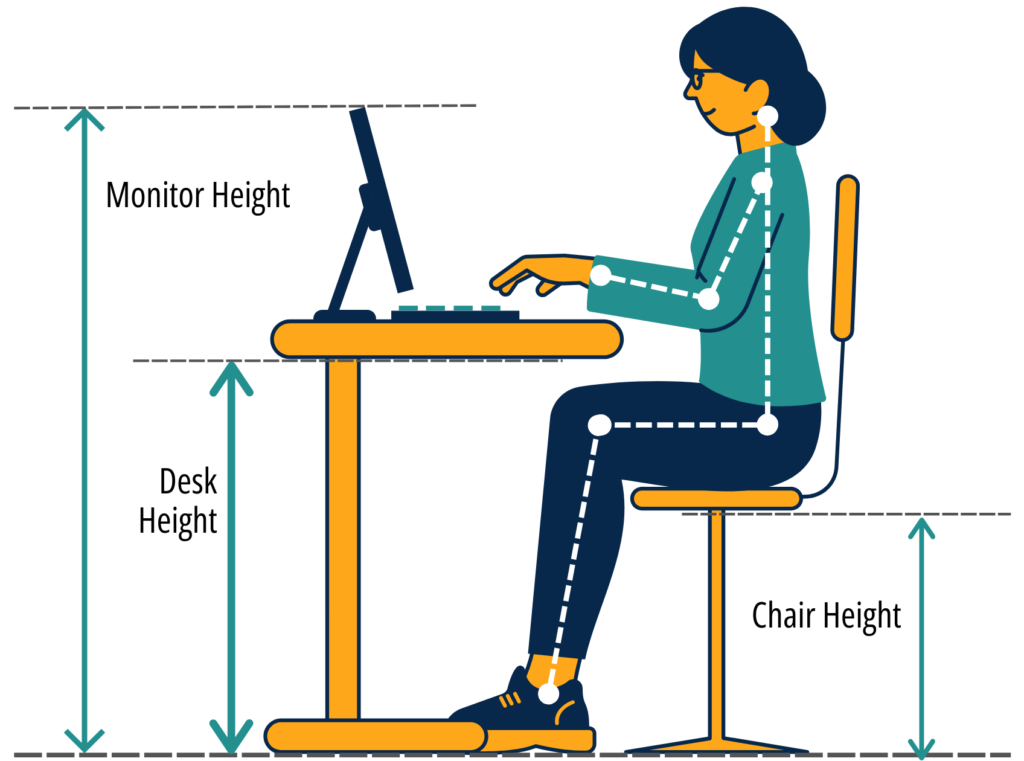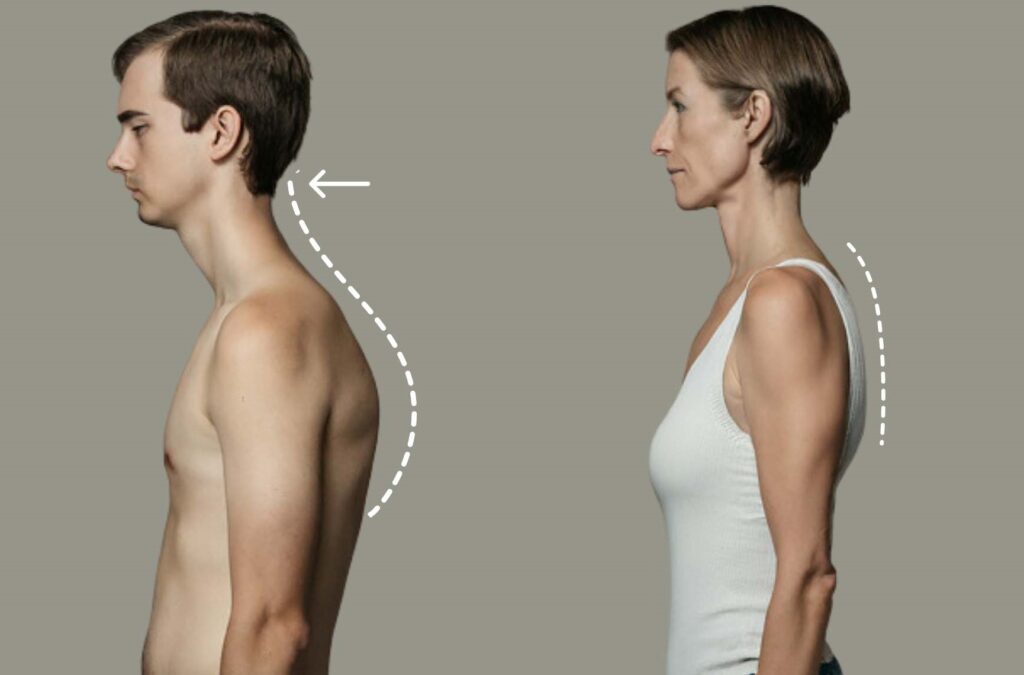Last updated on March 31st, 2025 at 06:17 pm

What’s the best exercise for cervical spondylosis?
Cervical Spondylosis is a common neck pain condition caused by the degeneration of the cervical spine. Commonly seen with ageing, in which the spine around our cervical area becomes degenerated with time.
Due to this, there is inflammation and swelling of the cervical spine, which can further result in the development of stiffness of muscles around the neck area.
In this article, we will mainly focus on cervical spondylosis treatment using conventional physiotherapy exercises. However, for better clarity on the subject, we will also answer questions such as its common symptoms.
What are the symptoms of spondylosis in neck?
Cervical spondylosis may present with mechanical neck pain, radiculopathy or a combination of both 1.
- Neck pain: Neck pain is the most common symptom. In the early stage, the neck pain is isolated to the neck, but in the late stage, it may radiate broadly to the shoulder, the upper back area between the shoulder blades and even to the head.
If it radiates to the head, it can result in cervicogenic headache. The pain is spread to these regions, and it becomes difficult for the sufferer to pinpoint the exact origin of the pain. - Cervical spondylosis radiculopathy: Neck spondylosis sufferers often complain of a tingling sensation in the arm, forearm even fingers. In an even later case, they may complain of numbness in their fingers.
This is because of mechanical compression and inflammation of the cervical nerve. Cervical nerves are the nerves that exit from the cervical spine level and travel down to the arm, forearm and fingers. The compression could be due to a cervical disc bulge or hypertrophied facet joint 1.
Can cervical spondylosis be cured with exercise?
The most effective and permanent way to manage cervical Spondylosis is the exercise. Research also establishes the effectiveness of exercise.
In a study involving 870 participants with symptoms of radiculopathy who were treated with exercises, almost all reported a reduction in pain and symptoms following exercises2.
5 Easy exercises to cure cervical spondylosis pain
So, here in this article, we are going to learn 5 effective cervical Spondylosis exercises that you can learn easily and perform at home.
These exercises are very easy to perform and are very effective, all these exercises you have to perform twice daily the idle time would be once in the morning and once in the evening. So, without delay, let’s start with the exercises.
These exercises are aimed to maintain the motion of the cervical joint and improving the strength and flexibility of the neck muscles.
1: Neck side bending
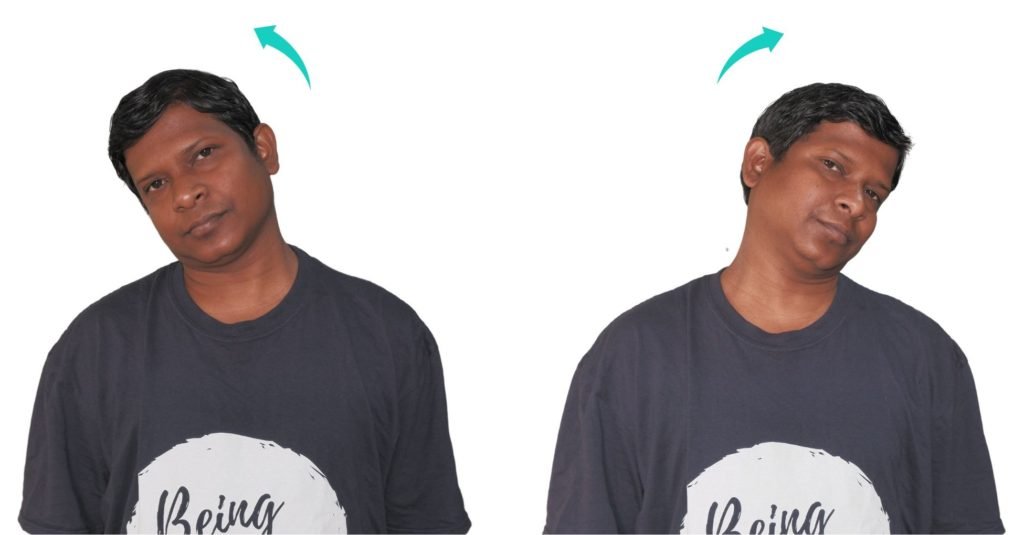
The first exercise for cervical spondylosis is the neck side bending exercise. For this exercise:
- Our starting position would be the same as the previous one, ie, standing or sitting straight.
- Now, in this position relax and then simply bend your neck to one side. Let’s say we start the exercise by bending it to the left side, then again bringing back the head to the neutral position.
- Then again bend it to the right side again, bring it back to the neutral position, and band to the left side.
- Repeat this process smoothly and slowly without any jerks. Repeat it 20 times in a single session.
This is a range-of-motion exercise that will prevent neck stiffness, it will help to maintain the motion of the cervical spine, which is very important to prevent any future degeneration.
This exercise and the next few exercises like neck rotation and neck forward bending are all categorised under the range of motion exercises. So, with this, let us move to the next exercise, which is neck rotation.
2: Neck rotation exercise for cervical spondylosis
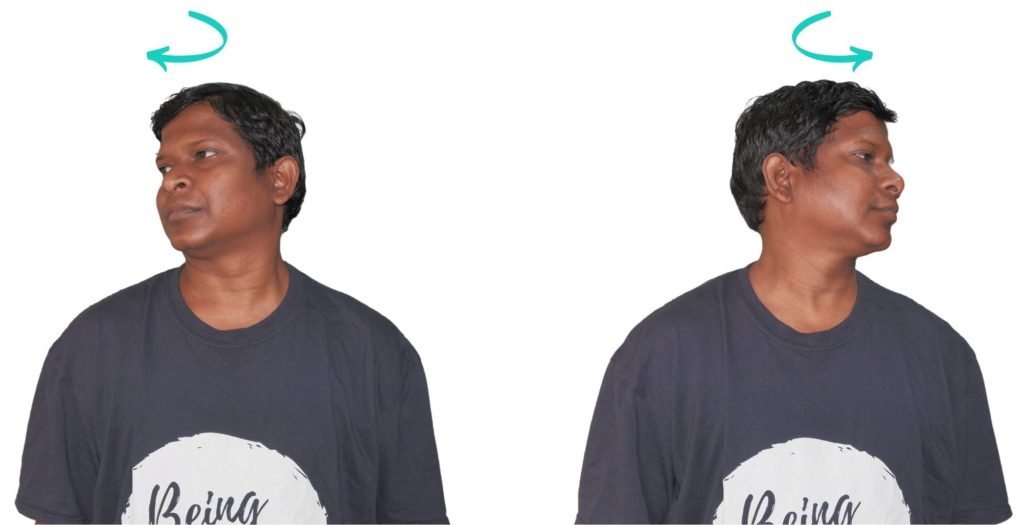
- For this exercise for cervical spondylosis, sit or stand straight and in a relaxed position, then rotate your head to one side.
- Let us start by rotating it to the left side and then slowly and smoothly rotating it to the right side.
- Then again rotate it to the left side.
- Repeat this process of rotation from left to right and right to left a minimum of 20 times in a single session.
As I have just mentioned that it is also a range of motion exercise that will maintain your neck rotation range
3: Neck extension exercise
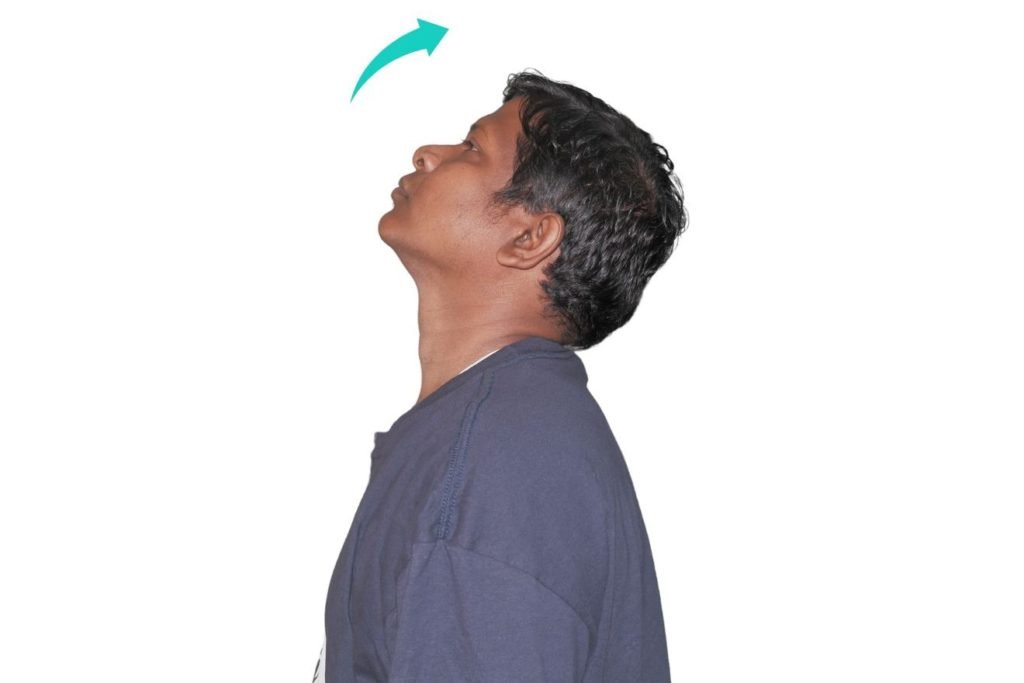
The next cervical Spondylosis exercise is neck extension.
- In a relaxed sitting/standing position simply bend your head to the backside. You have to extend your neck and perform this motion smoothly and slowly without any jerking.
- After extending it then bring it back to the neutral position.
- Again, repeat the extension of the neck.
- Likewise, repeat this exercise a minimum of 10 to 15 times in a single session.
One important point you have to note here is that we don’t have to bend it forward. Neck forward bending or neck flexion will further degrade cervical spondylosis conditions, so we have to prevent neck flexion.
4: Neck muscle stretching
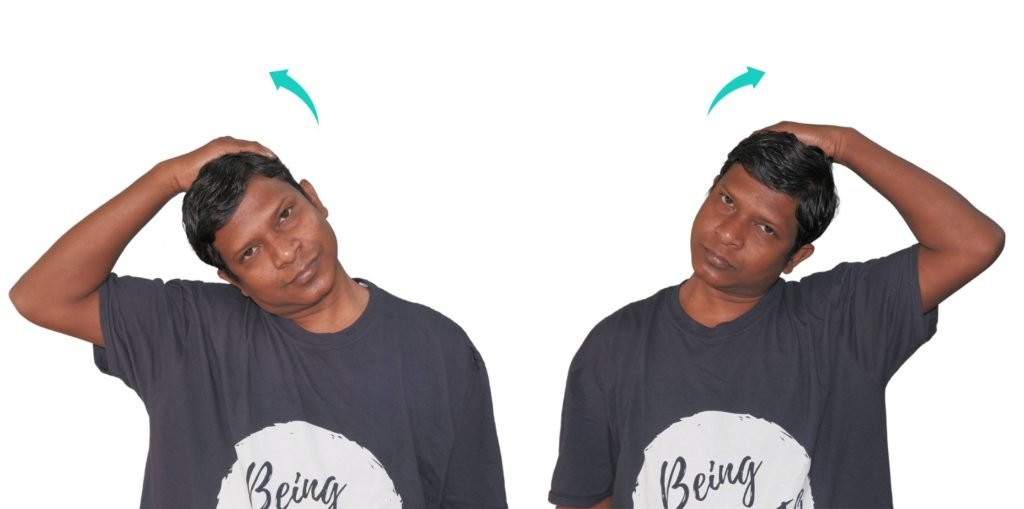
The next exercise for cervical spondylosis is stretching exercises. These exercises are meant to stretch and release the stiff muscles around our Neck area.
In cervical Spondylosis, because of pain, we often prevent neck motion, and many doctors advise using a cervical collar during severe pain. But, because of this rest period, there is a high chance that the muscles around the cervical area may become stiff.
By doing these neck stretching exercises, we can release the stiffness of these muscles. For stretching exercises:
- The starting position would be the same stand or sit straight and relaxed position.
- Then, to stretch the left side neck muscles, take your right hand and place it over the temple area just above the ear and then slowly and gently pull it towards the right side.
- Pull it and take it to a point where you will feel a comfortable stretch on your left side neck muscles.
- Now, hold this position for a minimum of 30 seconds and then release it slowly.
- To stretch the left side and right side neck muscles, you have to use your right hand Place your right hand over the Right temple area and then pull it toward the left side and hold it for 30 seconds.
- Repeat this stretching exercise on each side 4 to 5 times in a single session
5: Neck strengthening exercise for cervical spondylosis
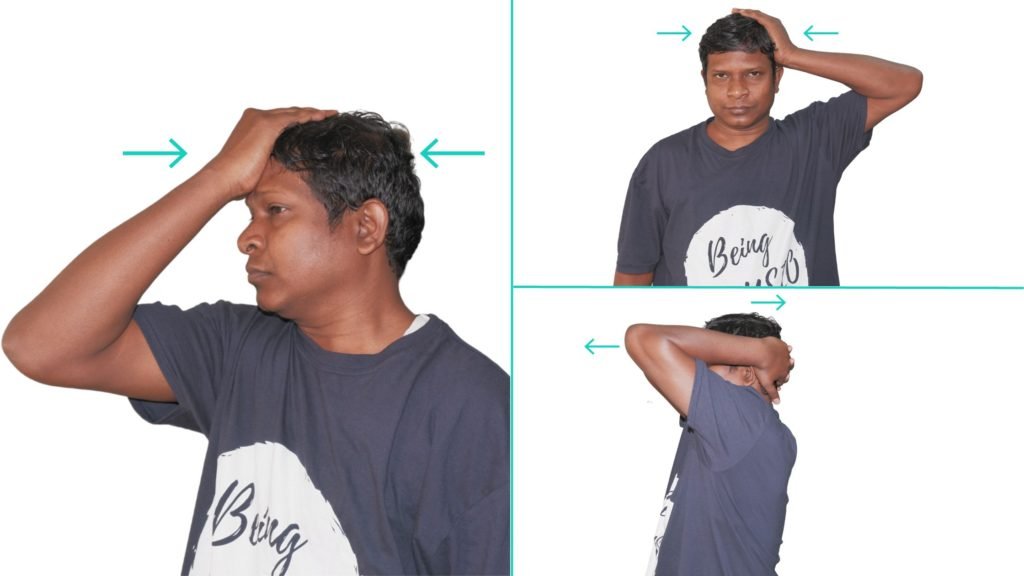
The final exercise for cervical spondylosis is the strengthening exercise. Because of pain and immobilization, there is also a chance of developing weakness of these muscles around the neck area, so we have to also take care of the weak muscles.
For this, the best is a neck strengthening exercise. The neck strengthening exercises are designed such that we can strengthen all the muscles around our neck, the muscles on the left side, the muscles on the right side the neck muscles on the front and on the backside.
- Let us start with a strengthening of the neck muscles on the left side. To strengthen the left side neck muscle take your left hand and place it over the temple area.
- In this position, hold the hand steady and bend your head to the left side. Simultaneously, you have to resist this neck bending with your left hand.
- Press your head against your left hand and hold this position for 5 seconds and then release it.
- Repeat the same process a minimum of 10 times.
The exact same procedure you have to repeat on the right side.
- So, keep your right hand on the temple area
- Bend your head to the right side against the resistance of your right hand.
- Hold it for 5 seconds and repeat it 10 times in a single session.
Next is to strengthen the muscles on the front of the neck:
- Take your right hand and place it over the forehead.
- Now bend your head forward against the resistance of your hand again.
- Hold it for 5 seconds.
- Repeat it 10 times.
Finally, we have to also strengthen the muscles on the back side of the neck.
- For this, grasp both your hands and then place them behind your head.
- Now, move your head back against the resistance of the hand.
- Hold the best position for 5 seconds and then release it.
- Repeat the process a minimum of 10 times in a single session.
Key take away
These exercises will help maintain the health of your muscles of the cervical region, they will help improve the blood circulation around it. This exercise for cervical spondylosis will also prevent stiffness or contracture of these muscles and help to strengthen the weak muscles.
We recommend doing these exercises for a minimum of 15 days twice daily and you will find a tremendous result in your pain relief.
Keep Reading: 5 Easy Back Pain on Upper Right Side (and left) Exercises that Actually Work
The author is a physiotherapist who has been practising for the last 17 years. He holds a Bachelor's in Physiotherapy (BPT) from SVNIRTAR (Swami Vivekananda National Institute of Rehabilitation and Research), one of the prestigious physiotherapy schools in India.
Whatever he learns dealing with his patient, he shares it with the world through blogs and e-books. He also owns a YouTube channel, "Sunit Physiotherapist" with over 8 lakh active subscribers. Here, he shares everything he gets to learn serving the patient.



